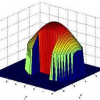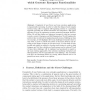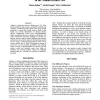1728 search results - page 4 / 346 » Self-Organisation: Paradigms and Applications |
ICANN
2007
Springer
14 years 1 months ago
2007
Springer
The Self-Organising Map is a popular unsupervised neural network model which has been used successfully in various contexts for clustering data. Even though labelled data is not re...
ICPR
2000
IEEE
14 years 8 months ago
2000
IEEE
Directional features extracted from Gabor responses are used as primitives for perceptual grouping. In previous work, we extracted Gabor features in 8 directions and then applied ...
EEMMAS
2007
Springer
14 years 1 months ago
2007
Springer
Complexity of near future and even nowadays applications is exponentially increasing. In order to tackle the design of such complex systems, being able to engineer self-organising ...
ATAL
2009
Springer
14 years 2 months ago
2009
Springer
Self-organising multi-agent systems provide a suitable paradigm for developing autonomic computing systems that manage themselves. Towards this goal, we demonstrate a robust, dece...
FLAIRS
2003
13 years 8 months ago
2003
Asthma is a distressing disease, affecting up to 7% of the French population and causing considerable morbidity and mortality. A medical decision support system such can help phys...



